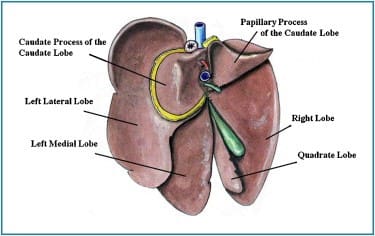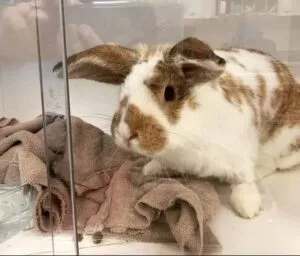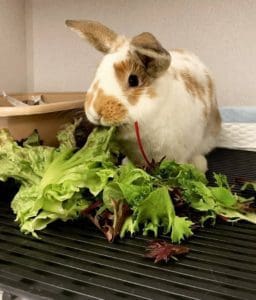This is the tale of the day I ALMOST died.

It was a few days before my second birthday and started as usual. My mom scattered leafy greens around my cage and hid my pellets in a box before leaving for work. Shortly after she left, I felt a pain in my stomach and retreated to my litter box. It hurt so bad and I didn’t move for the rest of the day. When mom got back from work, she opened my cage to let me hop around. Usually I’m binkying and causing all sorts of trouble, but that day I stayed put. She came to check on me and picked me up. Normally, I would not allow such disrespect but I just didn’t care. She knew this wasn’t like me and rushed me to the hospital. She gave me some fluids under the skin and pain medication. They ran some bloodwork showing that I was anemic and that my liver values were elevated. They then gave me some sedation so it gets a bit fuzzy after that, but they said that the x-rays and ultrasound showed that I had a liver lobe torsion.
What is liver lobe torsion?

Rabbit livers have 5 portions (or lobes): right, caudate, quadrate, left lateral, and left medial. The caudate lobe is especially pendulous and can twist on itself. When this happens, the veins are collapsed while the arteries remain open. This leads to continued blood flow INTO the affected lobe but not out. The liver lobe becomes distended and can begin to bleed into the abdomen. This is extremely painful and can lead to anemia and liver damage. Toxins, waste products, and free radicals build up in the twisted liver lobe. Further problems can occur if the liver lobe suddenly untwists as all of those compounds flow out into the body (reperfusion injury).
What are the clinical signs?
The most common clinical signs are vague. Rabbits can be quiet, have a decreased appetite and stool, be hunched and painful, have pale or yellow gums (dependent on the duration of the torsion).
Who is prone to developing it?
Lop rabbits are overrepresented in most case reports. It is suspected that they either have a laxity or lack of certain hepatic ligaments that allows the lobes to move more freely. Other factors include trauma or damage to the lobe, infection or tumors of the liver lobes, and enlargement or dilation of other abdominal organs.
How is it diagnosed?
Bloodwork is our first line diagnostic. The presence of anemia and elevated liver enzymes are very suggestive of a torsion. Confirmation is achieved with advanced imaging like an abdominal ultrasound or computed tomography (CT).

My mom and some other people worked hard on me. I got lots of medications and they tried to place an intravenous catheter so I could get a blood transfusion. It took them 40 minutes because my blood vessels were very delicate and prone to bleeding. Once it was in place I was started on fluids, but I couldn’t make my treatment easy. I chewed out the catheter before the transfusion could take place. They had been planning to take me to surgery to remove the liver lobe, but it was deemed too risky with my clotting issues and that the catheter couldn’t be kept in place. I was put in the hospital overnight and monitored very closely. By the next day I was feeling much more myself. I punched one of the staff members and ate a whole bulb of fennel. My mom kept a close eye on me and gave me SO MANY medications. I was on pain medication, anticoagulant medication, gastrointestinal protectants, and liver support medication. My mom also fed me high iron greens to help me make more red blood cells.

How is liver lobe torsion treated?
Most cases of liver lobe torsion are treated with rapid supportive care like pain medication and fluids. Dependent on the severity of the anemia a blood transfusion may be recommended. Surgical removal of the affected liver lobe is the recommended treatment as it will stop the bleeding and remove the risk or the lobe untwisting. Some cases can be managed with aggressive medical therapy if they are either poor surgical candidate or mildly affected. These animals are managed with continued supportive care, activity restriction, and liver support.
What is the prognosis?
The prognosis of rabbits affected with liver lobe torsion is guarded. This disease advances very quickly and a rabbit can go from fine to gravely ill in a matter of minutes. Prompt medical attention is imperative to obtain the best outcome. Unfortunately, some rabbits do pass away even with the best of care.
For weeks afterwards I had to go to work with my mom so she could monitor me and give me my medications. I got poked a lot so they could check that my anemia and liver values were improving. I also got repeated ultrasounds to monitor what was happening to my twisted piece of liver. The piece always stayed twisted but slowly scarred down on itself. Eventually I got back to normal business (chewing on things I shouldn’t, playing with the cat, trying to steal food). 18 months later and it’s like nothing happened!


About Us
Our exotic animal hospital is dedicated exclusively to the care of birds, exotic small mammals, reptiles, and even fish! We can offer everything your pet needs for a healthy and happy life, from wellness care and grooming to diagnostics and dentistry, but we can also provide emergency care during our opening hours, along with more specialized treatment for referred patients.
